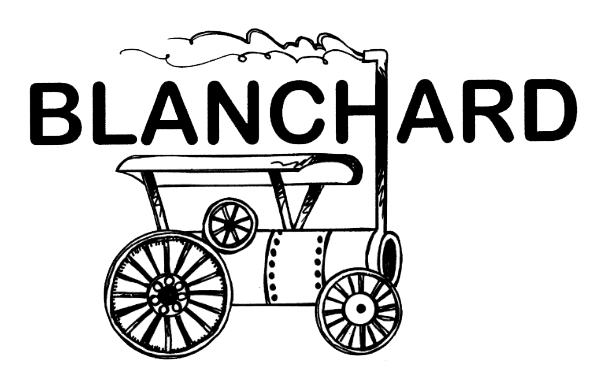LIFE IN BLANCHARD: THE DEPRESSION OF 1929
The Pioneers of Blanchard, Idaho by Fielden L. Poirier, written in 1972
(Editing by Barb Hornby 2002)
During 1929 the stock market went on a rampage. Stockholders wanted to sell at once and this caused stocks in the large companies to be forced down lower until the situation became very critical and a panic condition existed. Factories were forced to shut down or reduce production, which put many people out of work. Building stopped and many new projects were delayed. To add to this hectic condition, the Mid-West had several years of drought on the farms of the Dakotas and Nebraska. This, together with low prices for wheat and farm products, forced many people to leave their farms and seek a living elsewhere. Many of these farmers came west to north Idaho where they could get jobs working in the woods. While the pay for this work was very low, at least it made them a living.
The Humbird Lumber Company of Sandpoint decided to close their saw mill operations and dispose of their lands and timber holdings in Bonner County. Their holdings were principally in Spirit valley near Blanchard. For several years previous to this time Fielden L. Poirier (father of Sonny Poirier), had been purchasing cord wood stumpage and some land from the company. Mr. Ole Pierson, father-in-law to John Humbird, was in charge of making the sale and gave the purchase opportunity to Fielden. The purchase proved to be fortunate for the Blanchard community.
Spokane and the Inland Empire used principally wood for fuel at that time, and so there was a ready market for cordwood. Since many people were out of jobs, there was no trouble in getting woodcutters and so a very active business developed that lasted through the depression years and afterwards. During these years, the timber was loaded for shipment onto railroad cars in Blanchard. Fir and Tamarack brought $4.50 per cord and Black Pine, $3.50 per cord (this had to be green cut and seasoned). The dead cut Black Pine brought $2.50 per cord. The woodcutters received $1.00 per cord for cutting the wood in 4-foot lengths and piling it in the woods.
Fielden put many men to work and supplied some of their needs through the store he operated (The Blanchard Trading Company). The workers lived in small houses built in the woods near their work. For men wishing to cut wood, the Blanchard Trading Company furnished a saw, an ax, maul, and wedges, and weekly groceries—this generally amounted to about $15.00. A good worker could cut about one cord of wood each day; others did even better. These men would generally stay all during the winter but most of them would drift off to better jobs during the summer. In the fall they would return to woodcutting and continue again through the winter. Many of the families that came here during those hard times bought cut-over land from Fielden, on time, paying for it by working in the woods and doing a little farming. Some of these original purchasers continue to reside here.
On March 6, 1933 with the inauguration of President, Franklin D. Roosevelt, banks were ordered to close, and this caused a very serious condition. All wholesale houses went on a cash basis. Our money in the banks was not available and no loans could be negotiated. The Blanchard Trading Company had to go on a barter basis for practically all of their dealings. Farm products and anything of value was taken in trade. Our supply base, Spokane, went on a cash basis and also used script as a medium of exchange for transacting business. Fielden who had been selling wood to the Johnson Bungay Fuel Company, in Spokane, previous to the closing of the banks, worked out a deal to trade cord wood for supplies for the store in Blanchard. Wood was shipped to the Johnson Bungay Company and they transferred credit to McClintock-Trunkey, our wholesale grocer, and they, in turn supplied Blanchard with groceries. The woodcutters took groceries in pay for cutting wood and the wood haulers did likewise. Since there was no money or medium of exchange, Fielden conceived the idea of having some brass made up in 25 cent, 50 cent and $1.00 coins. This was good for trade only. It was successful inasmuch as it provided a means of convenient exchange. The brass was used for several years, and after the banks were opened we drifted back to normal times again. The brass in circulation was redeemed however, many coins were never returned.
Blanchard got through the depression because of the cooperation of the people. By working together our little community came through these hard times with very few scars and our needs were provided for. The best supporter Fielden had during these times was his father, Louis M. Poirier. Louis contributed advice, finances and help to his son and to Blanchard as a whole. Other help is credited to the Humbird Lumber Company of Sandpioint, Mr. Hohn Humbird, and Ole Pierson, the McClintock -Trunkey Company, Jensen Byrd Hardware, Johnson Bungay Fuel Company and many more. Fielden said, “For all of them, I am grateful and I hope that another depression of this nature will not visit us again.”
(Editors note: The pioneering spirit of people like Fielden L. Poirier and those he mentioned still lives on in Blanchard. These courageous leaders brought community success during the depression years and even now. For it is through their example that we can continue without failure. The same dedication and cooperation remains in “The Little Town That Could”—FOR WE ARE “Spirit Valley” and the inherent qualities we have been gifted with will continue to reside here in good times and in bad. Sometimes it takes a crisis, or the telling of one, to show us what we have and to reveal our hidden strength and undiscovered talents. )
History of the Blanchard Post Office
Sources: The Pioneers of Blanchard, Idaho: The Spirits That Made Spirit Valley by Fielden Poirier Sr. 1977, Writings by Charles Barker, Charles Cook, & (Bryon Defenbach -1933 History of the Gem State).
Postmarked Idaho: A List of Idaho Post Offices--Compiled by Guy Reed Ramsey for Idaho State Historical Society 1975. Internet source: https://webpmt.usps.gov/pmt003.cfm.
—Editing and rewriting by Barb Hornby February 2003
The early history of mail service to the Blanchard area began primitively in 1880 with a relay station near where Rathdrum is now located. The station was for packers and furtraders and was located on the old Wesley Wood’s place. At that time very few people lived in the area. The nearest post office (to Blanchard) was established on the banks of the Pend Oreille River in 1890 at a point called Newport, Idaho. Mike Kelly, a young Irishman built a log store and he was successful in getting a post office established there. Mail was carried from Rathdrum Idaho, through Spirit Valley (Blanchard) and then to Albeni Falls by horse team and buckboard. The postal station on the Pend Oreille River was called Newport because it was a “new” “port” on the river. Jacob Martin, father of William and Clara Martin, carried the mail in the early years for this station. Later the station was moved across the Washington State line and was renamed Newport, Washington. The first postmaster there was R.I. Towle.
About the same time (1890), William A. White homesteaded 160 acres in Section 18, Township 54, Range 5, Bonner County (Kootenai at the time). The surrounding area (now Blanchard) was named White, Idaho after this early settler. Nate Presnell, (brother of J.H. Presnell) also homesteaded in White (property later owned by John Watson Sr.) and he carried the mail from Rathdrum, through the Spirit Valley (Blanchard/White) and back from Newport. From 1892-1893 Joe Poirier who owned and operated a blacksmith shop in Rathdrum carried the mail and light freight to White, Idaho where his brother Louis (Sonny Poirier’s grandfather) lived. He further transported mail to Newport and to Albeni Falls on the Pend Oreille River where his other brother (Albeni) lived. The first wagon trail was built by the Poirier brothers and other pioneers who widened an old Indian and trappers trail which was already in existence. This was a 32-mile trek used by the Kalispell and Coeur d'Alene Indians for many years before the white man came west. White, Idaho’s first post office was officially commissioned in 1903 with William White as the first Postmaster. Mail service was operated out of Mr. White’s home and was delivered to his farm by pony express.
When Mr. White sold his homestead and left the valley, Earl Rusho married Susie Jackson and settled on the Sammon’s homestead (Section 20, Township 54, Range 5, now owned by Doug Yergens and June Rusho Yergens). Earl took over as postmaster starting in 1904. In 1907, J.H. Presnell, who lived south of the Rusho farm, succeeded him. In 1908 a mail station was established on the Frank Rusho farm and the station and town were re-named Blanchard after another early settler, Joe Blanchard. Railway service came through here that same year. RR Friend built a store just north of the station and the location of the post office was moved into the 30x60 RR Friend store building. On January 1, 1912 this store was expanded and combined with two other neighboring stores (Coleman and Hubbard Stores) and it became the Blanchard Trading Company, LTD. The Blanchard post office remained in the Blanchard Trading Company for many years and several postmasters (listed in this newsletter) provided service. Several of the postmasters were also the proprietors of the store including Claude Blanchard, grandson of the pioneer for whom Blanchard was named. The post office remained at the Blanchard Trading Company store location until 1986. The current location is in a separate building in downtown Blanchard, just to the east of the old Blanchard Trading Company store. The post office is now owned and operated by the US Postal Service and Mariette Deems is the postmaster.
Note of interest: In 1937 the original mailboxes were replaced with new ones and the old boxes were stored at the Poirier museum in Blanchard. Today, these mailboxes are on display in the nostalgic area of the Old Town Hardware store on Hwy 2 in Old Town, Idaho. The names are still legible on the back of each box. You are welcome to go and see a part of Blanchard’s postal history by visiting the display at Old Town Hardware store.
History of Postmasters & Officers In Charge
FOR WHITE/BLANCHARD, IDAHO
June 1, 1903--William A White--Postmaster
April 8, 1904--Earl Rusho--Postmaster
Grandfather of Cliff Rusho, June (Rusho) Yergens, Ila (Rusho) Strange
April 15, 1907--J H Presnell --Postmaster
White, Idaho became Blanchard, Idaho Sept. 19, 1908
Sept. 19, 1909-Ernest J McLaughlin-Postmaster (less than a month)
October 5, 1909--R.R. Friend--Postmaster
March 12, 1912--J.H. Presnell--Postmaster (again)
January 14, 1913--Tom Sollie--Postmaster
January 14, 1914--Frank Rusho--Postmaster
November 3, 1921--Fielden Poirier Sr.--Postmaster
From 1912-1921 Fielden (father of Sonny Poirier) was
Assistant Postmaster (except for time in Marine Corps-1917-1919)
August 31, 1959--Claude B. Blanchard --Acting Postmaster
December 2, 1960--Claude became Postmaster
June 9, 1972--Harold W. Pinkham--Officer-In-Charge
Sept. 2, 1972--Harold became Postmaster
May 18, 1979--Patricia Sturgill--Officer-In-Charge
March 22, 1980--Donald J. Doran--Postmaster
November 23, 1996--Michael Griffin--Officer-In-Charge
March 15, 1997--John R. Clark--Postmaster
December 1999--Kathy Hodgson--Officer-In-Charge
June 2000--John R. Clark--Postmaster
May 29, 2002--Zachary W. Bonds--Officer-In-Charge
July 17, 2002 to Present--Mariette Deems--Postmaster



